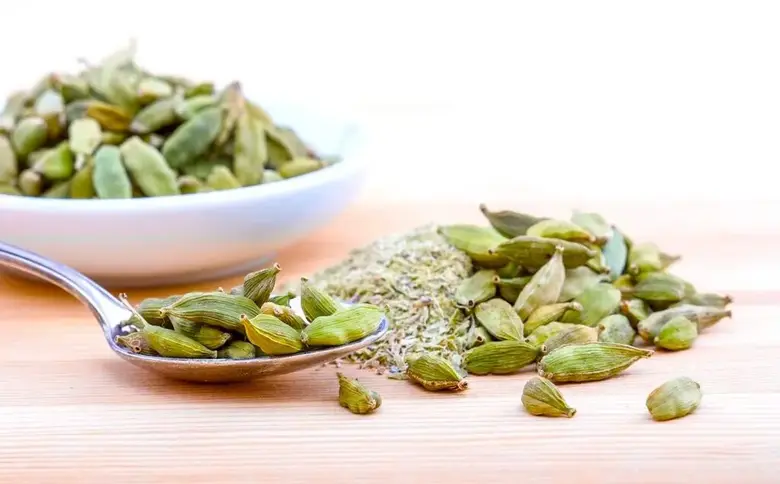cardamom vs. Coriander - What's the difference?

When you’re trying to elevate your culinary skills, it’s important to understand spices. A pairing that always causes confusion is cardamom and coriander.
What are the differences between cardamom and coriander? Cardamom and coriander seeds have similar uses in cooking. However, cardamom is a spice from the ginger family, while coriander is from the parsley family. Both are also different in terms of their appearance and flavor notes.
Read on to learn about cardamom and coriander, their flavor profile, their uses in cooking, their spice combinations, and much more.
What is cardamom?
Cardamom is a spice from the ginger family. Originally from Asia and a staple in Indian cuisine, cardamom is now produced in different parts of the world. It has seed pods and is usually in powdered form.
Cardamom has two main varieties: black cardamom and green cardamom. The latter is often called true cardamom and is the most widespread variety of cardamom.
What is coriander?
Understanding coriander is a bit difficult. If you’ve always thought of coriander as a plant, you might be surprised that someone confuses cardamom with coriander.
The matter is the following. Coriander is an herb that comes from the parsley family and the Coriandrum sativum plant.
In the US, the seeds of this plant are called coriander, while the leaves and stems are called “cilantro” . Translated from Spanish, the latter means coriander leaves.
In many other countries, the dried seeds of the Coriandrum sativum plant are called coriander seeds and the leaves and stems coriander leaves.
It is coriander seeds that many people confuse with cardamom.
What are the differences between cardamom and coriander?
To understand the differences between cardamom and coriander, we are going to compare some aspects of these seeds.
Aspect
Distinguishing cardamom and coriander seeds when they are not ground is quite easy. Coriander seeds are small and ball-shaped. Although these seeds can be used whole, coriander seeds are usually dried and ground for convenient use.
Cardamom seeds, on the other hand, come in pods. They are spindle-shaped and quite difficult to open. Each pod contains several seeds. The seeds are small and black.
You can free them from the pod if you manage to open the shell of the pod. It is easier to buy cardamom powder. The latter is made by grinding the entire cardamom pod.
Since powders tend to fade sooner, many cooks prefer to use the seeds. When you use cardamom seeds, you have to crush them with a pestle to release their flavor.
flavor profile
The flavor of cardamom is quite intense. It is sweet and spicy. Many describe cardamom seeds as lemony and also as mint.
Black cardamom is also known for its smoky notes and cooling effect.
The flavor profile of coriander seeds is earthy and sweet. Cardamom has a floral aroma. The floral aroma of the seeds is accentuated when you toast them.
Like cardamom, coriander seeds are considered by many to have lemony undertones.
In general, both cardamom and coriander are not overly potent when used sparingly.
spice pairing
Both cardamom and coriander pair well with cumin, cayenne, ginger, allspice, chili, and cinnamon. They also go well with each other.
Cardamom also goes well with mustard, paprika, aniseed, and turmeric. Coriander seeds, meanwhile, go well with fennel seeds and garlic.
Applications
When it comes to cooking uses, cardamom and coriander have some similarities. You can use both cardamom and coriander not only in savory dishes, but also in sweet dishes.
If all you use is salt and pepper, you may be intimidated by adding these seeds to your recipes.
But both coriander and cardamom are very versatile. If you combine them with the right ingredients, they will yield tasty results.
Use coriander seeds with all kinds of meats, from poultry to lamb. Accompany the coriander with cruciferous vegetables and fruits to accentuate its lemony floral notes.
Cilantro, with a flavor between cinnamon and lemon zest, is a perfect addition to dessert dips, crumbles, and other baked goods.
As for cardamom, you can use it in meat dishes, combine it with legumes and different cereals. Bakers use cardamom to flavor cookies, cakes, and other sweets.
Since cardamom is very aromatic and has unique flavor notes, you can also use it in drinks. Accompany cardamom with tea or coffee to discover the magic of these seeds.
You can also use cardamom in alcoholic drinks and cocktails.
Like coriander, cardamom pairs exceptionally well with fruit. Cardamom makes the best combinations with lemon, oranges, apricots, apples, and pears.











